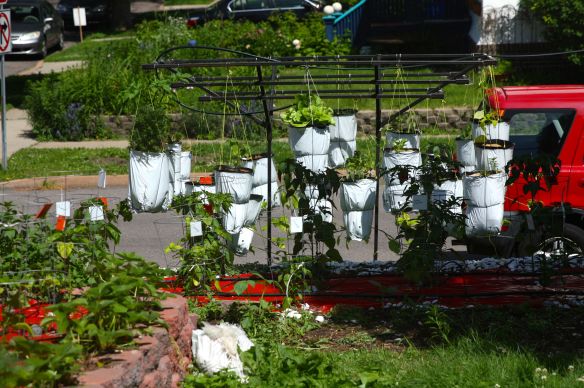June 21, 2015 – Macalester-Groveland, West End/West 7th, West Side – 14.7 miles
Today is the summer solstice, one of my favorite days, mainly because it’s the longest day of the year (more play time!) In Saint Paul, we enjoy 15 hours, 37 minutes, and 4 seconds of daylight. To top it off, it’s also Father’s Day.

Which way do I go?
Pascal and Palace – Glad I’m on my bike. If I was walking, I might still be at this intersection trying figure out which way to go.
Down the Hill
After that brief stop in Mac-Groveland, I flew, figuratively speaking, down the Jefferson Avenue hill, peaking at 30 miles per hour, according to my GPS. Enjoying the descent almost, almost makes up for the slow, grueling, sometimes painful pedal I frequently face on the way home.

Palace Recreation Center and the Sergeant James M. Wosika Jr. Memorial Fields.
As Jefferson leveled out, I came to the Palace Recreation Center and the Sergeant James M. Wosika Jr. Memorial Fields, where I paused.
Sergeant Wosika, a Saint Paul native and 2000 graduate of Highland Park High School, was assigned to the 2nd Combined Arms Battalion, 136th Infantry in Crookston. He died January 9, 2007 in Fallujah, Iraq, from wounds sustained when an improvised explosive device detonated near his unit while on combat patrol. The Saint Paul City Council approved the memorial in August of 2007.

In summer, the rink is set for boot or blade hockey. In the cooler months, ice hockey takes over thanks to Mother Nature and the attached refrigeration unit.
Behind the Palace Rec Center/Wosika Memorial Fields sign is an obviously iceless hockey rink. That meant inline rather than ice skates for Auggie Garcia and his children. “We’re an active family. We like to hang out and play sports,” Auggie told me.
“We decided to come out here and spend a nice day, and being Father’s Day, they gotta listen to me,” Auggie added, laughing.
Auggie grew up on the West Side of Saint Paul, where he spent most of his time, though he occasionally visited North Minneapolis. “My mother is from Minneapolis and going over to Grandma and Grandpa’s house was a little different from being here in Saint Paul.
“My first experience with remembering anything about Minneapolis is going over to the North Commons (a park on the near north side of Minneapolis) and getting my bike stolen. That’s probably one of the reasons I don’t like it as much.”
So it’s no surprise that Auggie remains a Saint Paul person to the core. “I coach boys basketball at Saint Paul Humboldt and then I coach girls softball at Cretin-Derham Hall and I’m working for the City of Saint Paul.”

Athena, 17, Isaac, 7, and Olivia, 10, pause for a picture.
Auggie and I talked for a few more minutes, mostly about children and what we like about Saint Paul, before I moved on.

Issac and Olivia battle as Athena skates on her own.
Palace Recreation Center, just south of the ice rink, is in the throes of a major and much-needed expansion and upgrade.

Work began this past spring on the expansion and remodeling of the Palace Recreation Center. This is the part of the original structure, built in 1974, that will be part of the improved rec center.
Money ($40,000) was allocated back in the City’s 2008 Capital Improvement Budget (CIB) for preliminary planning and design work. Although the renovation and expansion were ranked in ’08 as the sixth most important CIB project, planning the architectural design didn’t begin until September 2014. As one of Saint Paul’s most used rec centers, the repeated delays in funding the construction project understandably caused a great amount of unhappiness among area residents. The $5.8 million expansion is expected to be completed in 2016, according to the St. Paul Pioneer Press.
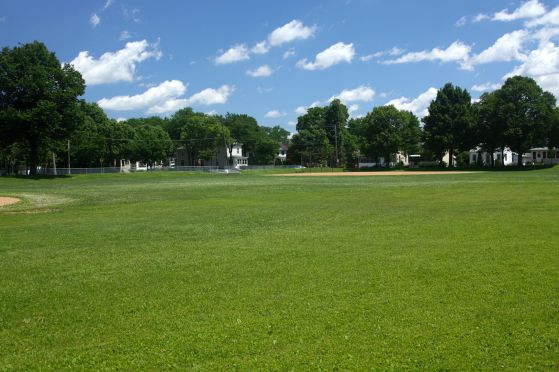
The fields at Palace Rec Center.
Reminders of Schmidt
Several blocks away, on Toronto Street, are a couple of surviving buildings from the old Schmidt Brewing Company. Today, multiple business are located within what was Schmidt’s shipping warehouse.

This creative, unique sign belongs to Vantage Painting, 360 Toronto.

The AAA Automotive Member Services is at the other end of the building, at 370 Toronto.

Several Triple-A vehicles remain in the garage, awaiting a call, on this fine summer day.
Back on the bike for a couple of blocks as I rode to 855 West 7th Street. That’s where I took my first close look at the one-time home that figured prominently in the history of beer brewing in Saint Paul.

Built for the Stahlmann family, this became home to the Schmidt family in the early 1900s.
The house was built in the early to mid-1870s for brewery owner Christopher Stahlmann and his family. (The Stahlmann Brewery was the largest in Minnesota at the time.) The limestone mansion remained in the family until the about 1900.
Jacob Schmidt, a German immigrant and brewmaster at Hamm’s on Saint Paul’s East Side, purchased the brewery (and the house) in 1902, the start of more than 50 prosperous years producing beer, and during Prohibition, soda and near-beer.
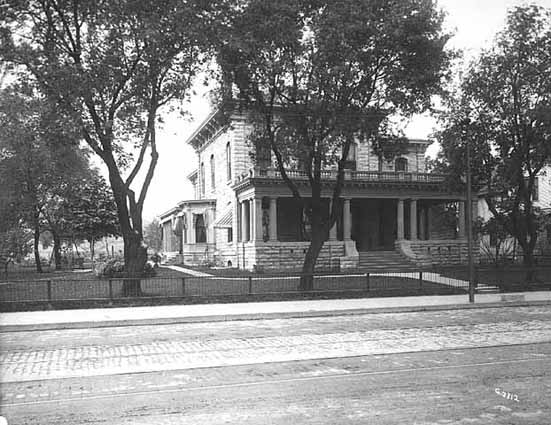
The Marie Schmidt Bremer House and grounds in 1920. Photo courtesy of Minnesota Historical Society.
This block evolved from what is most accurately described as an estate, to what is now a rather typical city neighborhood. The St. Paul Heritage Preservation Commission described the neighborhood this way in a 2011 report:
“In the Stahlmann and Schmidt years the block was densely planted with trees, with orchards to the rear as well as boulevard plantings. The major alterations to the landscape that took place in the last century were the replacement of the beer garden and saloon by two quite typical residential lots and the filling of bare land at the northwest corner with a growing number of connected buildings and parking lots. These changes all took place within the period of significance and in fact were brought about by the brewery ownership.”

Even with the heavy traffic along West 7th, it’s not hard envisioning the convenience the Stahlmanns, and later the Schmidt family, enjoyed living across the street from their brewery. This is the view from the front porch of the former Bremer home.
The 1934 kidnapping of Edward Bremer, Jr. spurred his father, Adolf Bremer, to have a tunnel built from the Bremer home, under West 7th, to the brewery. Today, although the house still has the Marie Schmidt Bremer sign on the porch overhang, it is no longer a single family home.
Today, although the house still has the Marie Schmidt Bremer sign on the porch overhang, it is no longer a single family home.

It’s hard to see the Marie Schmidt Bremer Home lettering on the overhang of the porch.
Reentry West, as it’s now called, is a group home for men who’ve had contact with the correctional system in Ramsey County, Hennepin County or the State of Minnesota. The house is owned by the non-profit RS Eden, where counselors assist former inmates with educational support, job and housing help and other support as residents re-enter society.
—
For many years, the West 7th Car Wash was more conspicuous than now, as it wore a two-tone coat of Dodger blue with navy accents. Some of its charm was lost with the cement block expansion and its boring beige and coffee brown color scheme. The official address of the car wash is not on West 7th, rather 356 Clay Street.

The defunct West 7th Car Wash. The self-service wash closed and the property forfeited to Ramsey County for nonpayment of taxes. Some 90 years newer than many of the nearby homes and businesses, the unusual architecture and construction (pointy Quonset huts) make it stand out.

In 1976, the car wash was called Mr. B’s Royal Car Wash. It was enlarged since this photo was taken. Courtesy of the Minnesota Historical Society.
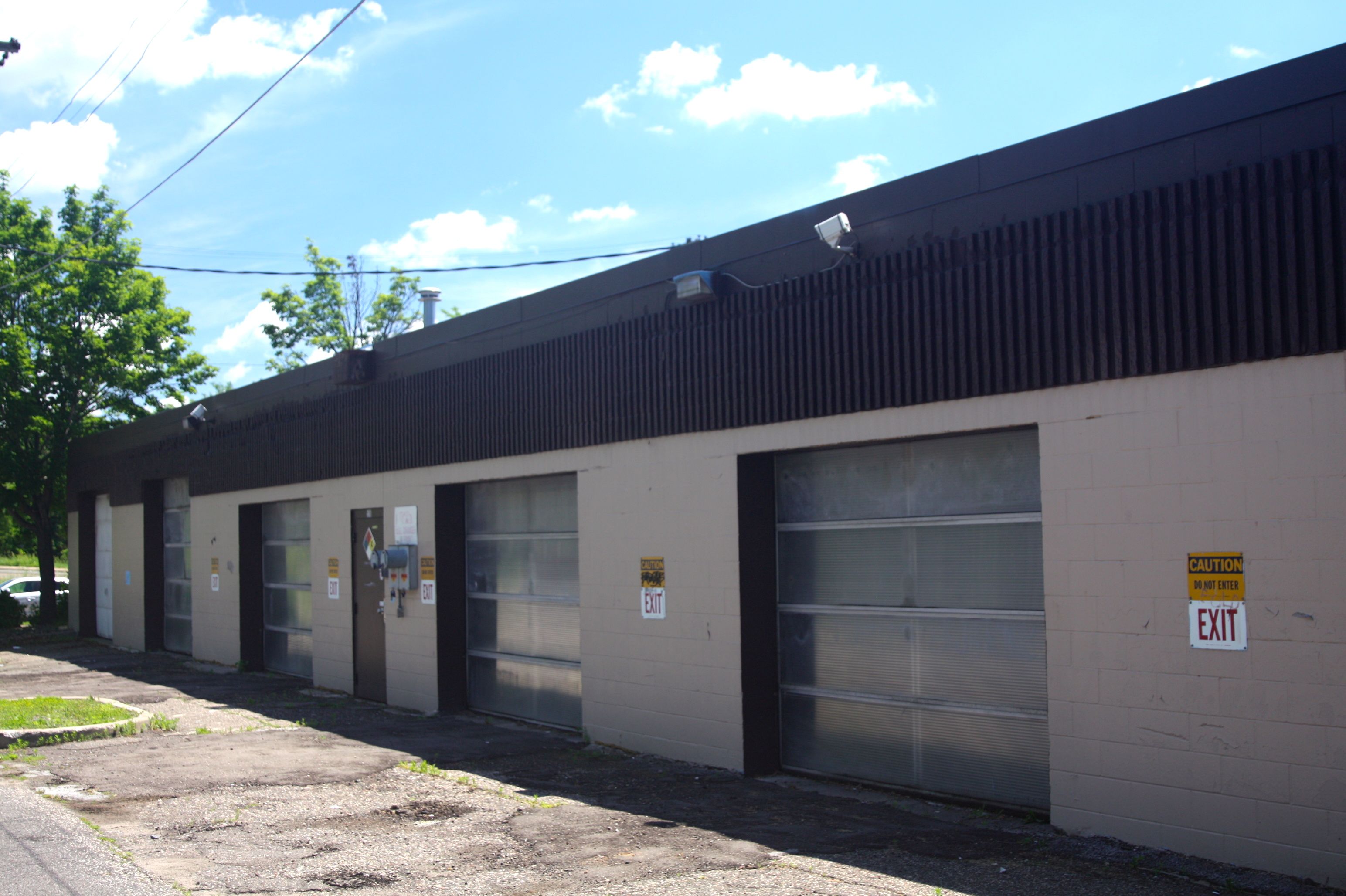
The most recent addition to the West 7th Car Wash is along Clay Street.
Several blocks east of the car wash is an odd intersection, where two streets with three names, intersect. South Ann Street runs into and ends at St. Clair Avenue, an east-west street. St. Clair also ends at this intersection and becomes Cliff Street.

The street changes in absolutely no observable way, but St. Clair Avenue becomes Cliff Street. Even the address numbers continue uninterrupted.

These granite blocks and a couple of others not in the frame sit among the grass just south of where St. Clair and Bluff Streets meet. Google, nor the Facebook group “Old St. Paul Minn”, shed much light on what these are, who placed them and why.
On the north side of the street, across from the granite blocks, is a vexillologist’s dream. (A vexillologist studies flags and there are dozens to study in this yard.)
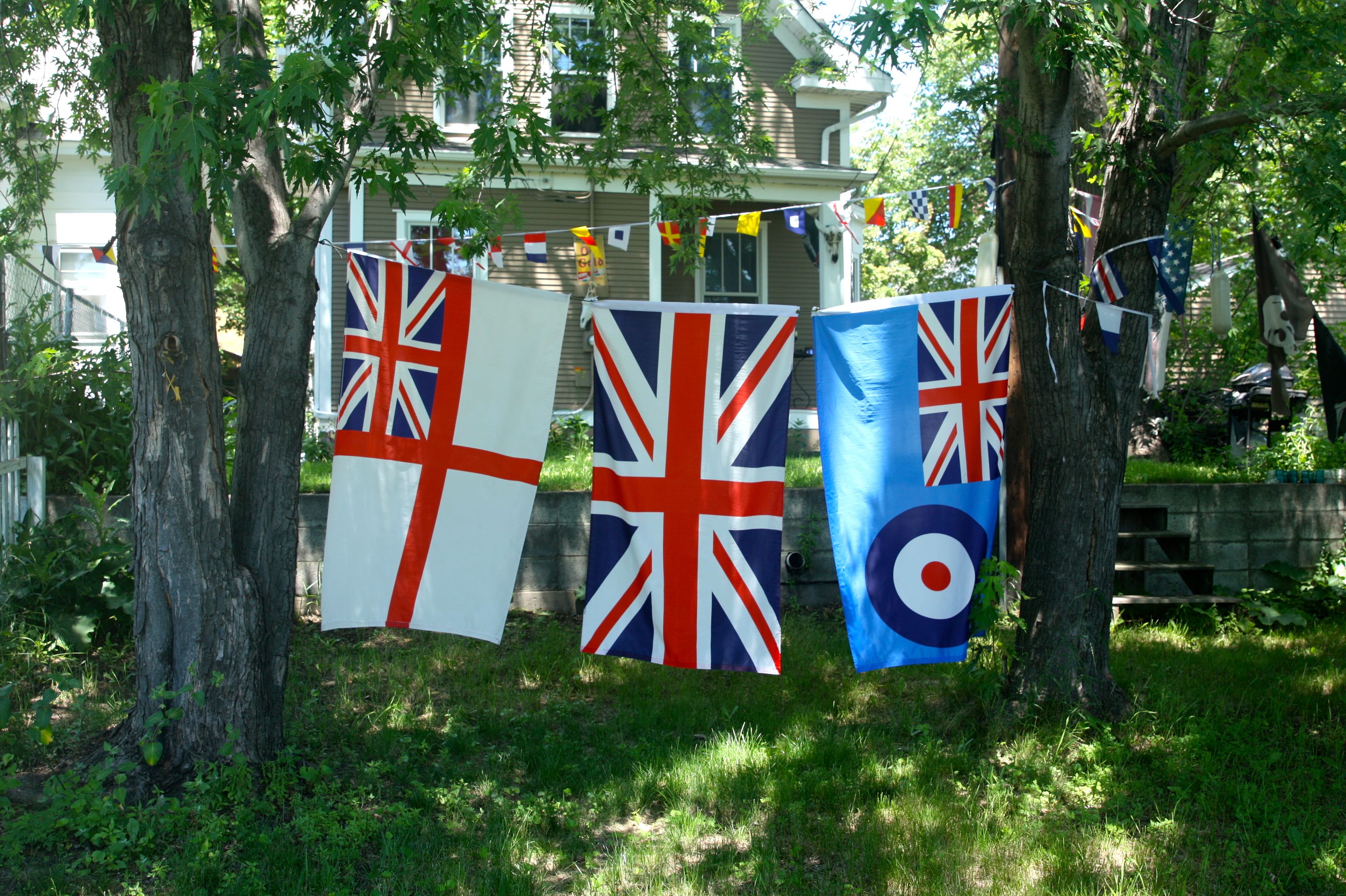
The three flags, left to right, are the United Kingdom Naval Ensign “White Ensign”, the flag of the United Kingdom and Dhekelia, and the United Kingdom Royal Air Force Ensign flag.
In the back yard, many small flags represent nautical codes.

The flags in the background are primarily nautical.

The skull and crossbones represent another side of sailing.
The nature of the flags changed as I moved from the back to the side yard and then to the front of 320 Michigan Street.

On the front porch the vibe is “N’Orlins.”
I knocked on the door to get the explanation behind the flags but either no one was home or they chose not to answer, perhaps mistaking me for a solicitor.
From Michigan Street, off to the West Side via the High Bridge, always a great view and good exercise.
Annapolis Avenue is Saint Paul’s southern border with West St. Paul for all but about four blocks. That made me curious about why several street lamps on Smith Avenue south of Annapolis (in West St. Paul) are the same style as those on the Saint Paul side of Smith.

Looking north on Smith Avenue toward Annapolis Avenue, Saint Paul’s border with West St. Paul. The light post on the left is one of several of the same style as those in Saint Paul.

This is the base of one of several light posts in West St. Paul labeled this way.
Back in Saint Paul on Wyoming Street, (one block north of the Saint Paul/West St. Paul border) I stopped to peer at the home at 412 Wyoming. Ramsey County records say the house was built in 1894.

Among the reasons this house enticed me to stop is the mixed stone, brick and woodwork, the porch and the semi-circular window above the front door.

The foundation, likely limestone, supports two levels of brick and the wood siding on the top floor. The different non-matching brick on the side has me wondering about the story behind it.

For as long as I can remember, I’ve been attracted to homes that feature a turret, like 412 Wyoming. I think it has to do with wanting a “secret” space to retreat to.

This unusual building is the Johnson Peterson Funeral and Cremation, 612 Smith Avenue South. Construction of the original two-story structure was completed in 1906.
Cherokee Avenue east of Smith Avenue offers the best views of downtown anywhere in Saint Paul.

Among the buildings along the skyline (left to right) are: the 37 story Wells Fargo Place; Saint Paul City Hall/Ramsey County Courthouse; three Century Link buildings; the former Ramsey County Jail and Government Center East; Crown Plaza Hotel; First National Bank Building and Kellogg Square.

The Cathedral dominates the scene, overlooking several medical buildings at the United and Children’s Hospital campus.

The Minnesota State Capitol, in the midst of a $200-million renovation, also hovers prominently above the rest of Downtown.

The shuttered Ramsey County Government Center East and old County Jail stretch across the bottom of the shot. Both are in the process of demolition, which Ramsey County officials hope will open the scenic area to redevelopment. Other recognizable buildings in the shot, left to right, are two Century Link telecommunications facilities, a Securian skyscraper, the shared City and County Hall, Crowne Plaza Hotel and the 1st Minnesota Building, with the large red First sign.
—
More Mortuaries
Back in the West End, I passed another two mortuaries barely two blocks apart.

Wulff Godbout, a neatly built stone structure with a spotless lawn and impeccably manicured bushes, at Superior Street and West 7th.
The addition of an awning, subtraction of the sign, new windows (and a name change) aside, the Wulff Godbout Funeral Home has changed little from when this postcard was printed in 1945. Courtesy Minnesota Historical Society.

Just southwest is the Kessler & Maguire Funeral Home, which has been at St. Clair and West 7th since about 1926. That’s the original neon sign on the roof of the Tudor-style building.
—
The ride up St. Clair Avenue from West 7th Street to Lexington Avenue is nearly a mile and a half. In that span, according to Google Maps, there is a 125 foot elevation increase. Perhaps it’s that grade that (sub)consciously caused me to turn right on Milton Street, thus avoiding some of the hill. One block north, at Linwood and Milton Street, a front yard punctuated with green and red brought me to a standstill.
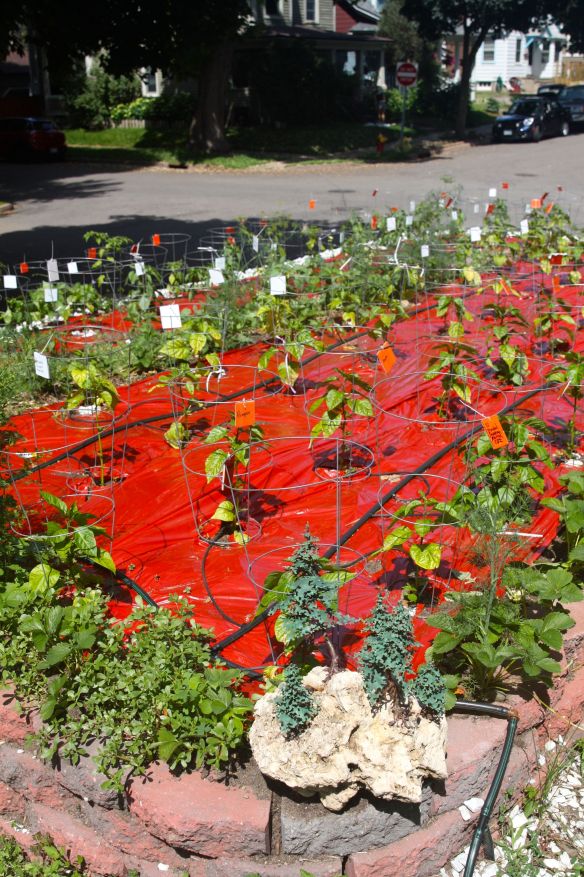
This garden at 922 Linwood is one of the most elaborate home gardens I’ve seen on my travels around Saint Paul.
Krishna Wilson told me he’s growing about 30 varieties of chili peppers in his front and side yards. “I grow a lot of the hottest varieties in the world. I have the Carolina Reaper, which is the world’s hottest at 2.5 million Scoville units. And then I have Trinidad Scorpion Morougas. They’re the second hottest in the world at 2.2 million.”
There’s more to peppers than just heat, Krishna said, “I also have some of the most flavorful peppers in the world. These Nu Mex Heritage 64s–that’s the base for my mild sauce. I smoke ‘em and roast ‘em and then make a sauce with it.”
I asked Krishna where his pepper passion blossomed. “I started growing peppers about eight years ago when I read an article in the newspaper about the Bhut Jolokia Pepper, which is referred to as the Ghost Pepper.
“They (the newspaper article) said I could buy seed from the Chili Pepper Institute of New Mexico. I decided to order some seeds and started growing ‘em and I was just hooked on it. I’ve loved gardening all my life; I’ve been gardening since I was knee-high to a grasshopper and this was just the thing for me.”
Growing peppers led to eating peppers, which Krishna said, “changed his life.”
“I feel like it helps stimulate your metabolism, it promotes health. So I feel it’s a healthful tonic. Then, also, there’s the exhilaration; I’m sure you’ve heard of chili heads and the endorphins and that kind of stuff. It’s just good, clean fun!”
“I like having a hobby and I never do anything half way.”
Krishna likely harvested thousands of chili peppers this year. The yield, Krishna explained, depends upon the variety of the peppers. “These Nu Mex Heritage are very productive. I’d say you get maybe 20 to 30 peppers per plant through the season. The Inca Red Drops, they’re maybe as big as your thumbnail, they’re about Cayenne heat level, but you can get 2 or 300 peppers off of a plant.”
In addition to homemade chili sauces, Krishna creates chili flake seasonings and gives peppers as gifts.
The chili peppers, sprouting in regimented columns began as seeds, according to Krishna. “I start these inside in mid-March in my sunroom under a big grow light. By the time I set them out, they’re usually a foot tall or so. I plant ‘em out the first week of June usually. I was two weeks earlier than that this year because of the fair weather that we had.”
Watering the dozens of pepper plants daily could be a full-time job, which is why Krishna set up an irrigation system. “When you have this many chili plants it’s pretty laborious to hand water them, so I started to use the drip emitter system about four or five years ago. All I have to do is go to my hose, turn on a timer and flip a switch and it waters all my plants at once. It also saves a lot of water because it only puts it at the plants where it needs to go.”
The red plastic lining the garden rows keeps weeds down and cuts evaporation of soil moisture, and enhances plant growth. “It reflects the infrared light back up under the plants which stimulates a plant hormone called phytochrome and it can give up to 150 percent more yield of fruit because it stimulates fruit production.”
Next, we chitchatted about the hanging garden, new this year, on the east side of the property. “I lucked into this structure here and I thought, ‘Let’s see how much you can grow in a six-foot by eight foot area.’ I call it the ‘Hanging Gardens of Babylon.’ I have two chili peppers in the bottom of each bag and then something else in the top–rosemary, tomatillos, lettuce, tomatoes, herbs, thyme, basil; all kinds of fun stuff.”
Toward the end of my visit, Krishna mentioned he grows hops plants, which naturally led to a conversation about beer. Then, blissfully, Krisha offered me a glass of his latest ale, which I gladly accepted after a feigned moment of indecision. The lovely golden brew was highly satisfying considering the 12 or so miles I’d ridden in 85 degree heat.
There is an abundance of thinking time when I’m riding. On the way home I recounted Krishna’s garden and our conversation. I was impressed and appreciative–impressed with his effort and commitment to his gardens and grateful for his time and insights.
Click on the link below to see the map of this ride, courtesy of my Garmin GPS.







